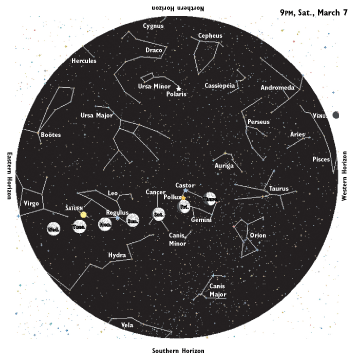
|
Volume XVII, Issue 10 - March 5 - March 11, 2009
|
|
Columns Reviews |
 |
Sky Watch by J. Alex Knoll
Benjamin Franklin’s
Big Joke
Today, Daylight Saving Time saves us big-time
Look for Friday’s waxing gibbous moon beneath the twins of Gemini. The brighter of the two, Pollux, shines an orange-yellow some five degrees away, while blue-white Castor shines 10 degrees above the moon.
Sunday the moon shines seven degrees to the right of Regulus, the heart of Leo the lion. Come Monday night, the two have swapped places, with Regulus the same distance to the right of the now-full moon. That same night, Saturn shines less than 10 degrees to the moon’s left, and on Tuesday the moon hovers above Saturn.
While the moon is full Monday, Saturn reaches opposition the day before, lining up opposite to the sun from our earthbound vantage. With the full moon and Saturn’s opposition so close, the two rise both days in the east as the sun sets in the west and are visible throughout the night before setting in the west at sunrise.
In lore, March’s full moon bears many names. Typically the last full moon of winter, it was named for the changing seasons. As the snow melts during the day and freezes again at night, it develops a crust, hence the Crusty Ice Moon. As the earth begins to warm, worms return to the surface, explaining the Worm Moon. With the thaw, sap again flows through the trees, giving us the Maple Sugar Moon.
Sunday at 2am marks our return to Daylight Saving Time, originally conceived in jest by Benjamin Franklin so farmers would work longer hours. Today, however, the savings are serious, as America reduces its energy consumption by about one percent each day during the time change. So don’t forget to set your clocks ahead one hour before retiring Saturday night.
Illustration: © Copyright 1925 M.C. Escher/Cordon Art-Baarn-Holland; Graphics: © Copyright 2009 Pacific Publishers. Reprinted by permission from the Tidelog graphic almanac. Bound copies of the annual Tidelog for Chesapeake Bay are $14.95 ppd. from Pacific Publishers, Box 480, Bolinas, CA 94924. Phone 415-868-2909. Weather affects tides. This information is believed to be reliable but no guarantee of accuracy is made by Bay Weekly or Pacific Publishers. The actual layout of Tidelog differs from that used in Bay Weekly. Tidelog graphics are repositioned to reflect Bay Weekly’s distribution cycle.Tides are based on National Oceanic and Atmospheric Administration and are positioned to coincide with high and low tides of Tidelog.
